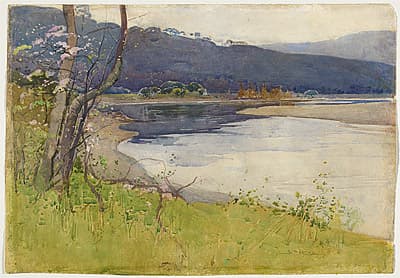
Sydney
LONG
Australia
1871
–
London
1955
England, Europe 1910-21; Australia 1921- 22; England 1922-25; Australia 1925-52; England from 1952
34.0 (h) x 52.0 (w) cm , no manufacturer's mark
Signed lower right within image in pen and black ink, 'SID LONG'. Not dated. Not titled. National Gallery of Australia, Canberra NGA 2012.49 Purchased with funds from the Ruth Robertson Bequest 2012, in memory of Edwin Clive and Leila Jeanne Robertson Reproduced with the kind permission of the Ophthalmic Research Institute of Australia.
- Purchased by the National Gallery of Australia, from Philip Bacon Galleries, Brisbane, 2012
Near the grassy bank of a river or lake are two trees whose branches flaunt their garlands of blossom and fill the air with fragrance. The subject of blossom suited Long’s delicate sense of colour, enabling him to express a certain mood, a feeling of nature coming into bloom, and a poetic fascination with the transience of beauty.
In Springtime, the air and water seem alive, but also still and silent. The scene is luminous and full of colour.
It is possible that this is a view of Avoca Lake in the Central Coast region of New South Wales, a peaceful recreation area and an easy train ride from Sydney. Long, however, was not so much concerned with depicting a specific place as he was with conjuring the powerful Spirit of nature, at a time of transition.
Long’s interest in decoration is evident here, with the curved trunks of the trees and the triangular forms of the hill, lake and foreshore. The hill’s reflection in the still water adds to the design. Rather than people his landscape with sprites, as he did in his more celebrated Art Nouveau images, in this watercolour, Long sought to evoke the Spirit of the land through the depiction of nature itself.
If this is an Avoca subject, the watercolour may be ‘Landscape Avoca’, which Long exhibited in the 1908 ‘Society of Artists exhibition’ (131).
Near the grassy bank of a river or lake are two trees whose branches flaunt their garlands of blossom and fill the air with fragrance. The subject of blossom suited Long’s delicate sense of colour, enabling him to express a certain mood, a feeling of nature coming into bloom, and a poetic fascination with the transience of beauty.
In Springtime, the air and water seem alive, but also still and silent. The scene is luminous and full of colour.
It is possible that this is a view of Avoca Lake in the Central Coast region of New South Wales, a peaceful recreation area and an easy train ride from Sydney. Long, however, was not so much concerned with depicting a specific place as he was with conjuring the powerful Spirit of nature, at a time of transition.
Long’s interest in decoration is evident here, with the curved trunks of the trees and the triangular forms of the hill, lake and foreshore. The hill’s reflection in the still water adds to the design. Rather than people his landscape with sprites, as he did in his more celebrated Art Nouveau images, in this watercolour, Long sought to evoke the Spirit of the land through the depiction of nature itself.
If this is an Avoca subject, the watercolour may be ‘Landscape Avoca’, which Long exhibited in the 1908 ‘Society of Artists exhibition’ (131).
Near the grassy bank of a river or lake are two trees whose branches flaunt their garlands of blossom and fill the air with fragrance. The subject of blossom suited Long’s delicate sense of colour, enabling him to express a certain mood, a feeling of nature coming into bloom, and a poetic fascination with the transience of beauty.
In Springtime, the air and water seem alive, but also still and silent. The scene is luminous and full of colour.
It is possible that this is a view of Avoca Lake in the Central Coast region of New South Wales, a peaceful recreation area and an easy train ride from Sydney. Long, however, was not so much concerned with depicting a specific place as he was with conjuring the powerful Spirit of nature, at a time of transition.
Long’s interest in decoration is evident here, with the curved trunks of the trees and the triangular forms of the hill, lake and foreshore. The hill’s reflection in the still water adds to the design. Rather than people his landscape with sprites, as he did in his more celebrated Art Nouveau images, in this watercolour, Long sought to evoke the Spirit of the land through the depiction of nature itself.
If this is an Avoca subject, the watercolour may be ‘Landscape Avoca’, which Long exhibited in the 1908 ‘Society of Artists exhibition’ (131).
